Grooming is an important part of horse care that every horse owner should know how to do. Not only does grooming keep your horse’s coat, hooves, mane, and tail in good condition, it is also a bonding moment for horse and owner as grooming is one of the things horses do to show affection to each other. Knowing how to properly groom a horse is essential, especially if you own a horse of your own already or are thinking of getting one. There are a few easy steps you can go through to make your horse nice and clean.
When grooming a horse, you want to groom them top to bottom, front to back. This way all the dirt you brush off of them doesn’t fall right over a patch you just cleaned off. This also helps to give your grooming more order and direction rather than just rubbing a brush on their coat. The order of grooming steps that I follow goes like this: Curry comb the whole body, use a body brush to get any stuck dirt, use a soft brush to do a final dusting and smooth coat, brush mane from bottom to top, brush the tail from bottom to top, clean the hooves, wipe down the face, wipe the horse’s eyes, and wipe their nose clean.
This is my process for grooming a horse:
1. Use A Curry Comb On The Horse’s Body
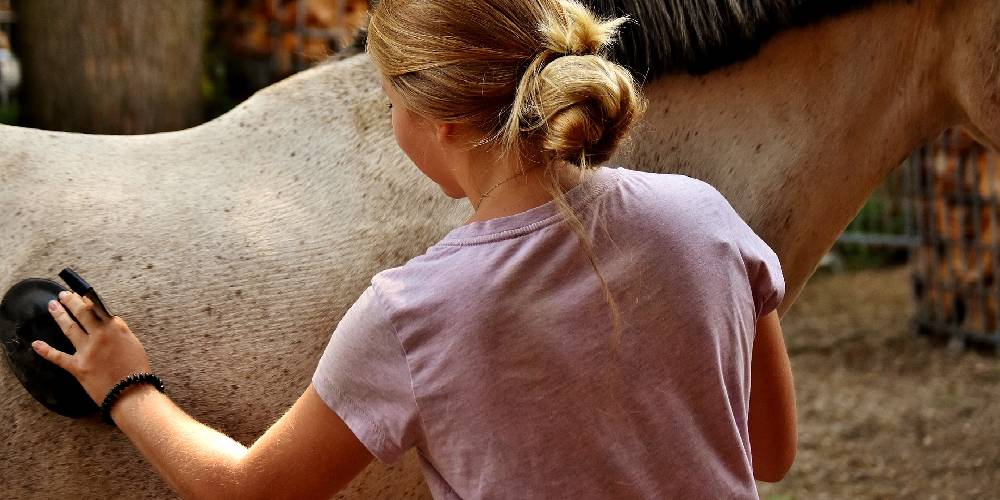
The first thing I use on the horse whenever I am grooming one is the curry comb. A curry comb is, in most cases, a rubber or plastic brush shaped in an oval pattern. Most curry combs will even have a strap that goes over your hand to help you hold onto the brush.
The curry comb is a brush that loosens up all the dirt, dust, old sweat, mud, and anything else that might be in or on the horse’s coat. Use this brush in a circular pattern both going with and against the horse’s coat. Start at the top of the horse’s neck and work your way down and across and back to their hindquarters before doing it again on the next side.
Because you are using this brush rather vigorously, I don’t recommend using this brush on the horse’s legs.
2. Use A Stiff-Bristled Body Brush To Remove Excess Dirt

I like to use a stiffer bristled brush after I’m done with the curry comb just to help brush out all of that dirt, mud, sweat, and dust that the curry comb loosened up. With this brush, I follow the same pattern as I did with the curry comb. Start up at the top of the neck and work your way down to the hindquarters.
To use this brush, perform long smooth sweeping motions with the brush and go with the horse’s coat.
Because this is a harder brush, I don’t really like to use this brush on the horse’s legs unless the legs are coated in mud. In that case, I would use this body brush to loosen up the mud and dirt and help to brush it away.
3. Use A Soft Brush To Dust Off & Smooth The Coat

Soft brushes are by far my favorite brushes to use. This is because not only do they feel smooth and soft, but they get all the last bits of dust off the horse and leaves them with a smooth shiny finish.
When using this brush, brush the horse in long, smooth, sweeping motions and do your best to get all that dust out of the horse’s coat. Like the body brush, you want to brush with the horse’s coat rather than against it. This helps to smooth out the coat better. Because this brush is soft and smooth, I will then use it on the horse’s legs to get any dust off of them as well.
Once I’m done with the dusting of the coat, I liek to spray a sort of finishing spray that makes the horse’s coat shiny and go over the coat with the bruish one last time. This leaves the coat looking even cleaner and shinier than before.
4. Use A Hair Brush On The Horse’s Mane
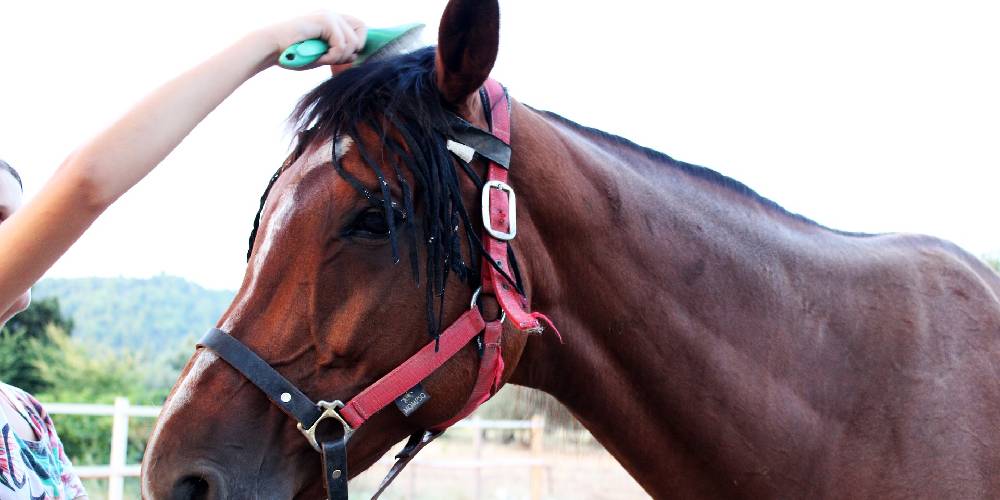
Once the horse’s coat is shiny and clean, I then move to the horse’s mane. With the mane, I start with the bottom of the horse’s neck at the bottom of the hair. I find that this works better when it comes to getting out any tangles. This way I can work the tangles out from the bottom to the top rather than making them worse by starting with the top.
If the horse’s mane is tangled, I like to spray a little bit of detangler or other spray to help make the detangling go quicker.
5. Brush Through the Horse’s Tail
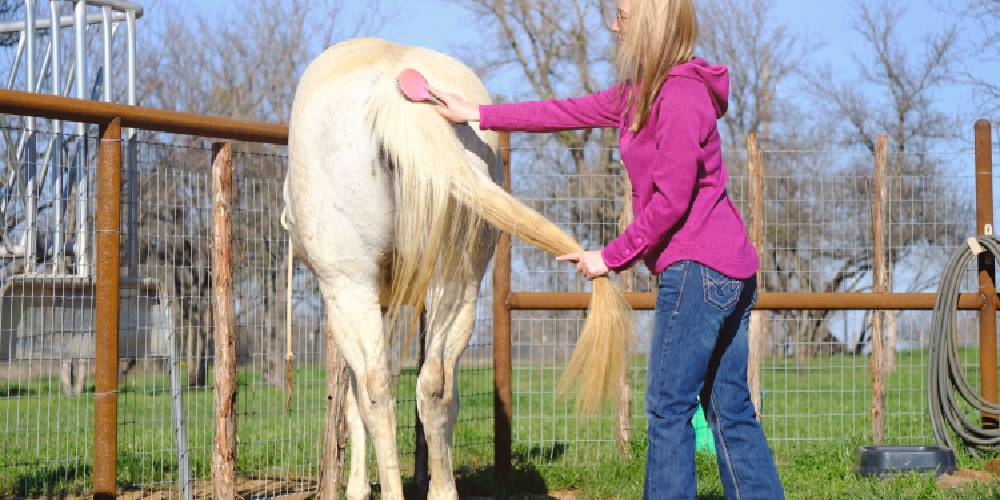
Just like when brushing the horse’s mane, I like to brush the tail from the bottom to the top. If the horse’s tail is really tangled and matted, I like to split the tail into a couple of pieces to make smaller more managable brushing sections.
Detangling spray works really well when it comes to brushing the tail so using this type of spray to make the brushing go quicker and easier is something I definitely recommend.
6. Pick Out The Hooves
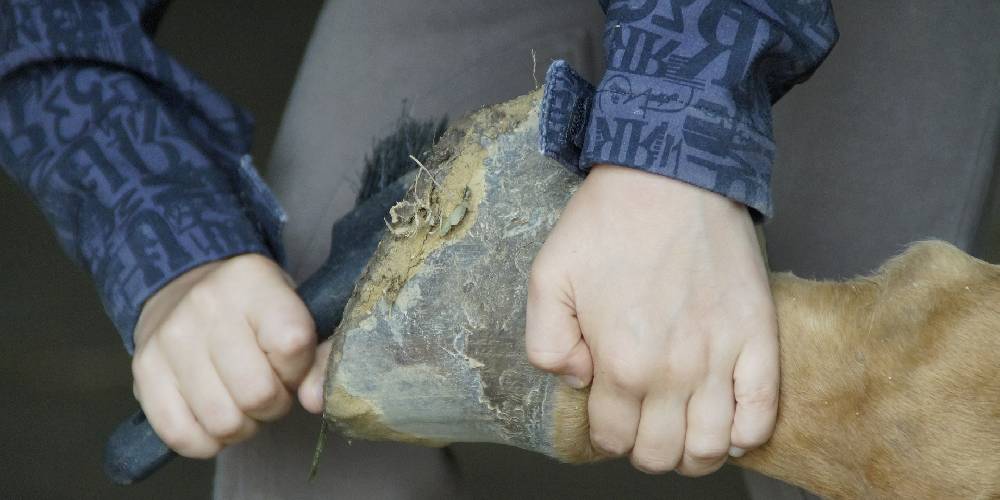
Cleaning out the horse’s hooves is probably the most important part of grooming. This is because the hooves are one of the most important parts of the horse. If the horse has poorly cared for hooves, the horse will likely develop lamenss issues and not remain healthy and sound.
To clean out the horse’s hoof, lean into your horse’s shoulder while facing the horse’s rear end. Then you will run your hand down the horses’s leg and try to pick up their hoof. Once you have the horse’s hoof in your hand, take a hoof pick and begin scraping all the mud, mnure, shavings, and whatever else has built up in teh horse’s hoof.
Sometimes the hoof will appear wet, flaky, or have a pungent smell. In this case, your hrose may have something known as thrush. To kill thrush and bring the horse’s hoof health back up to par, I like to use a thrush medication in the hoof if I ever notice that it is more wet than normal. this way the hoof doesn’t begin to develop issues.
7. Wipe The Horse’ Face Down
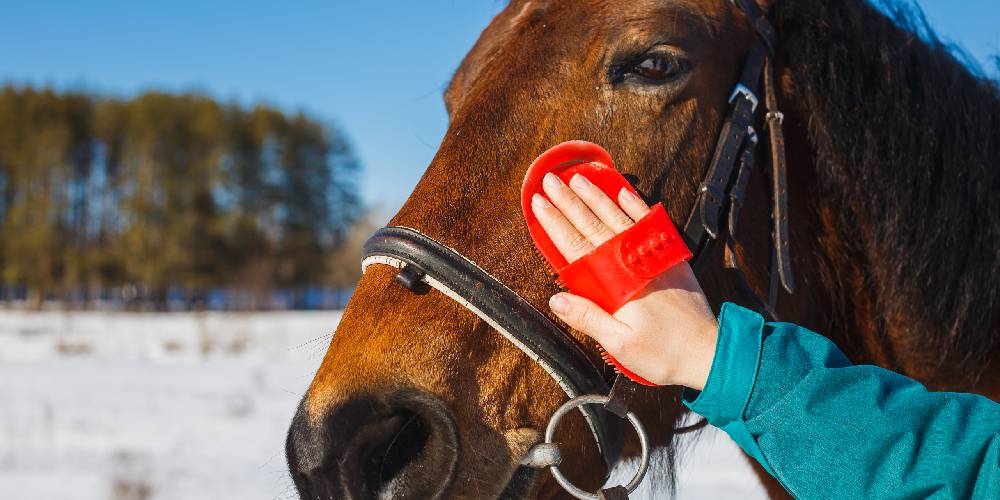
When the whole horse’s body, hooves, and hair is all nice and clean, I begin to tackle the face, To wipe the face down I will ususally use a damp rag and wipe the dirt and dust from their face and forehead. When cleaning the face, go with the direction of the hair to keep the haoitr on their face smooth and sleek.
8. Wipe Around The Horse’s Eyes
Using the same rag that I used to wipe the horse’s face, I like to wipe aroundd the horse’s eyes. Most horses will et a gunk build up arounf the corner of their eye so i liie to clear out any of that debris with the rag as I’m wiping around the horses’ eye.
9. Clean The Horse’s Nose & Nostrils
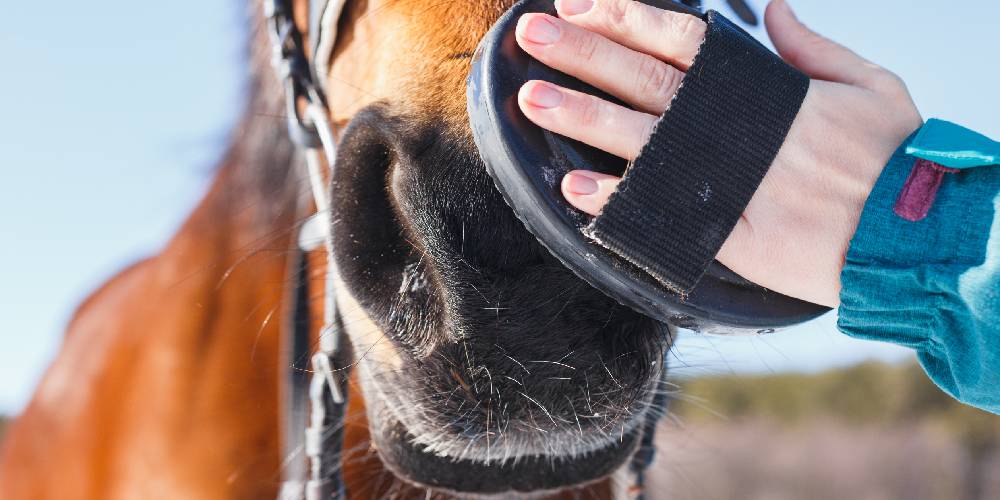
I usually will do the nose and the nostrils last because this area tends to be the least favorite and most uncomfortable place to clean in the horses’ viewpoint.
Using the same damp rag, I will wipe between the nostrils, the horses’s mouth, under the chin, and above the nostrils. This will get the horse not just used to the rag, but it will also help to remove any build up or dust that started to accumulate in these places.
Once the muzzle is clean, I move to the horse’s nostrils. I will usually put part of the rag over one of my fingers and use that in the horse’s nose to clean out any boogers, dirt, and dust that might be in the horse’s nose.
After you are done cleaning your horse, I like to spray thenm down with a fly spray and coat shining spray to finish up the grooming. This way the horse is left with a shiny healthy looking coat and the fly probelm is taken care of.
Are you ready to get grooming?

